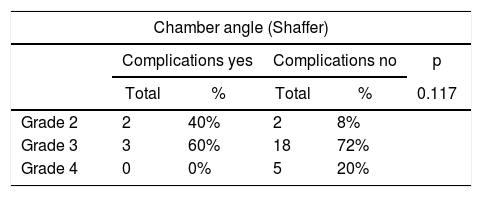Fluctuating elevated intraocular pressure (IOP) is one of the complications of an implanted collamer lens (ICL), and its alteration is a predictive factor for the development of glaucoma.
Material and methodsA prospective, cross-sectional analytic study was conducted on patients suitable for ICL implantation. Complete clinical and biometric work-ups were performed, as well as night-time IOP curve, in supine position, with 4 determinations, in order to assess fluctuation, considering abnormal with a value higher than 5 mmHg being considered abnormal. Three months after the patients underwent surgery, the work-ups were repeated, including a night-time IOP curve to assess any changes in IOP fluctuations.
ResultsA total of 31 eyes of 16 patients were studied. Mean IOP fluctuation in the preoperative assessment was 3.35 ± 2 mmHg, whereas the postoperative mean was 3.0 ± 2.2 mmHg, with the difference not being statistically significant. Visual acuity and capacity, as well as spheric equivalent did show a statistically significant improvement. There were 6 cases of complications, which were related to a higher vault and a greater ICL size. There was no relationship between these findings and the angle grade, pigment, and the level of training of the surgeon.
ConclusionsThe effect of an ICL on IOP fluctuations, has been studied for the first time, which was not statistically significant. As in previous publications, the procedure was safe and reproducible, adding the fact that the level of training of the surgeon is not a determining factor in these findings.
una de las complicaciones del implante de ICL es la elevación de la presión intraocular (PIO), la cual es fluctuante y su alteración es un factor predictivo para el desarrollo de glaucoma.
Material y métodosestudio prospectivo, transversal y analítico, en pacientes candidatos a implante de ICL. Previa valoración clínica completa, biometría y curva de PIO nocturna, posición supina, con 4 tomas, determinando la fluctuación, considerándose anormal arriba de 5 mmHg. Se les sometió a cirugía mediante técnica convencional. A los 3 meses se repitió valoración clínica completa, biometría y curva de PIO, para determinar si había cambios en las fluctuaciones de PIO.
Resultadosse estudiaron 31 ojos de 16 pacientes. El promedio de fluctuación preoperatorio fue de 3.35 ± 2 mmHg, mientras en el postoperatorio fue de 3.0 ± 2.2 mmHg, sin que esta diferencia fuera estadísticamente significativa. La agudeza, capacidad visual y equivalente esférico mostraron una mejoría estadísticamente significativa. Hubo 6 ojos con complicaciones, las cuales se relacionaron con un vault alto y un ICL de mayor tamaño. No hubo relación de complicaciones o fluctuaciones con el grado del ángulo camerular, el grado de pigmento o el nivel de entrenamiento del cirujano.
Conclusiónse exploró por primera vez el efecto del implante de ICL en las fluctuaciones de PIO, encontrando que no es estadísticamente significativo. Se mostró la seguridad y reproducibilidad del procedimiento, como en publicaciones previas, agregando que el nivel de entrenamiento del cirujano, no es un factor determinante en ninguno de dichos factores.













